by Ronny Vollandt
The presence of Christian Arabic texts in the Cairo Genizah corpus is well attested.[1] In her survey, Krisztina Szilágyi classes the compositions of Christian Arabic provenance which circulated among Cairene Jews into two groups. The first includes specimens of a variety of literary genres: polemics, theology, liturgy, historiography, and hagiography. Prominent examples found within this group include the Christian anti-Islamic ‘Legend of the Monk Baḥīra’, the ‘Disputation of the Patriarch Timothy I’, and also an extant leaf of the chronicle by Saʿīd b. al-Biṭrīq, Patriarch of Alexandria (933-940).[2] Additional fragments contain theological and homiletic works which remain unidentified. Composed for a Christian readership, the texts of this first group were originally intended for internal use.
Incomparably larger in quantity, the second group of compositions consists of works which address a broader, general readership, such as medical science or philosophy. Among the attested texts one finds, for example, an early fragment of Ibn Bahrīz’s (d. ca. 860) ‘Definitions of Logic’ (Kitāb ḥudūd al-manṭiq), Ḥunayn b. Isḥāq’s (808-873) ‘Medical Problems’ (Masāʾil fī al-ṭibb), Qustā b. Lūqā’s (d. 912) ‘The Introduction to the Art of Geometry’ (al-Madkhal ilā ṣināʿat al-handasa), ʿAlī b. ʿĪsā’s (d. 1010) ‘The Reminder of the Occultists’ (Tadhkirat al-kaḥḥālīn), as well as Ibn Buṭlān’s (d. 1066) ‘The Physicians’ Dinner Party’ (Daʿwat al-aṭibbāʾ).[3]
Szilágyi (p. 142*) stresses that the fragments identified in the Genizah collections thus far are “only the tip of the iceberg”. With the pivotal significance of these collections for Jewish studies, Christian – and also Muslim – material in them generally has suffered and continues to suffer a chronic disregard. This short contribution therefore sets out to contribute to our knowledge of Christian books in Jewish libraries by adding a third group of such texts, namely Christian Arabic Bible translations. Arabic versions of three parts of the Christian canon are attested: the Pentateuch, the book of Psalms, and the New Testament.
These texts have to be understood as yet another intrinsic part of the tapestry of biblical translations into Arabic which survived in the Cairo Genizah collections. Among the many worn-out manuscripts, one finds a multitude of translation specimens.[4] Samples belonging to the early and classical period are attested alongside those of later periods, undoubtedly bestowing upon the collections the distinction of being one of our main sources for the study of Judaeo-Arabic versions. The texts preserved items from a variety of provenances, geographical but also communal (Rabbanite and Qaraite).[5] In addition to these, however, both Samaritan and Christian traditions are also attested, although in a comparably lesser number.[6]
In what follows, I shall present a list of all fragments in the Cairo Genizah corpus that, to my knowledge, can be identified as containing Christian Arabic translations of the Bible. In contrast to the vast majority of translation specimens in the Genizah written in Hebrew script, these fragments are as a rule written in Arabic letters. While fragments containing translations of the New Testament may be considered Christian on the mere basis of the books they contain, the Christian provenance of parts of the Old Testament becomes evident for a variety of reasons. Some para-textual features can give the first indications of this, including the use of Coptic or rūmī numerals to numerate chapters, the chapter divisions themselves (e.g. following the Septuagint), or their names (e.g. aṣḥāḥ, a designation that usually points toward a Syriac Vorlage). Ultimately, though, it is only a comparison of the translation to the different text-types of biblical versions in Christian Arabic preserved in complete manuscripts from other collections that can confirm these first indications and can substantiate identification.
Fragments containing translations of the Pentateuch
Cambridge University Library (CUL), T-S Ar. 51.147 (Genesis 6:9-7:14)
2 leaves (bifolium), paper, 21.2 x 35.9 cm, 12 lines, naskh, sporadic vocalisation, rubricated chapter headings. It contains Saadiah’s Tafsīr in the Syriac Orthodox branch of transmission.[7]
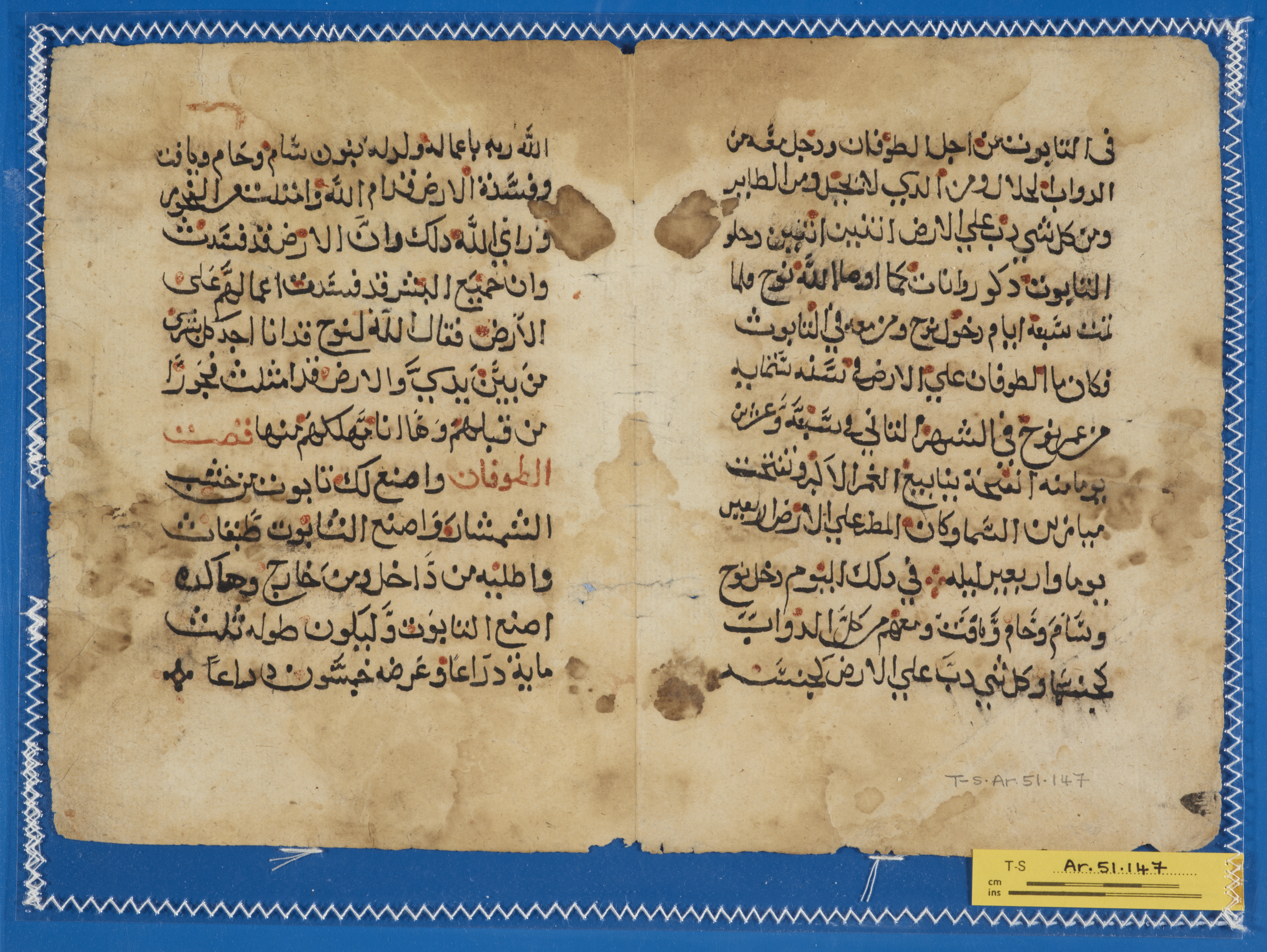
CUL, T-S Ar. 42.148 (Numbers 29:3-29, 30:14-31:12)
2 leaves (bifolium), paper, 19 x 29 cm, 11 lines, naskh, sporadic vocalisation. It contains Saadiah’s Tafsīr in the Coptic branch of transmission.[8]
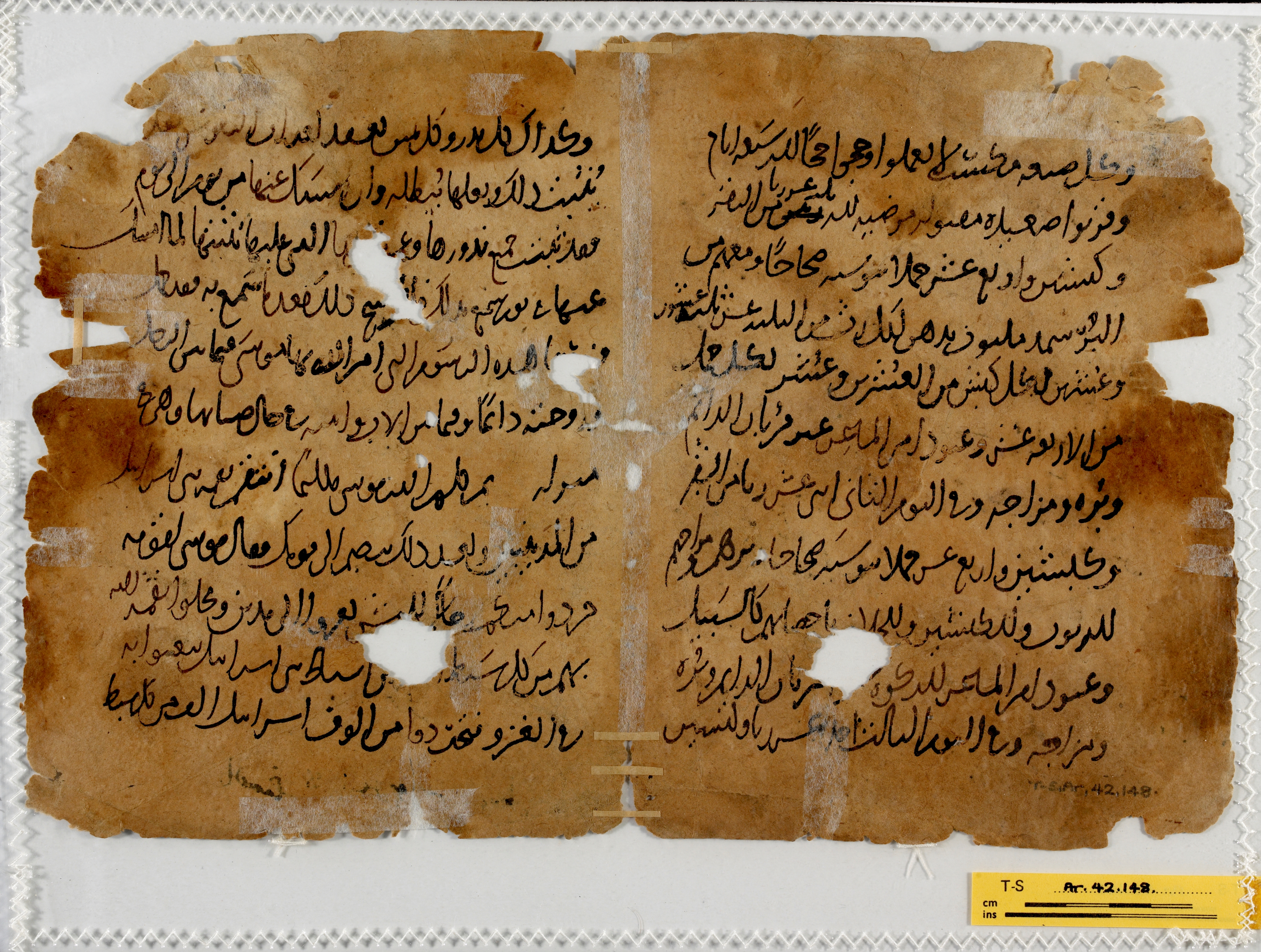
A translation from the Syriac
Another group of fragments of translations of the Pentateuch originated from three different codices. All exhibit the same translation type, based on the Syriac Peshitta, which is known from a large group of complete manuscripts from other collections. I have elsewhere classified this tradition under the siglum ArabSyr2.[9] It was a popular translation and is found in many manuscripts with a variety of geographical provenances, including Egypt and Spain. ArabSyr2 not only came to be the preferred translation of the Peshitta Pentateuch, but also completely replaced earlier translations of this Vorlage. The earliest attested manuscript in the group is MS Sinai, Arabic 4, which has a date of copying of 963 CE, and this thus serves as a terminus ante quem for the emergence of this version.
Manuscript A
CUL, T-S Ar. 41.122 (Genesis 26:15-27:17)
1 leaf, paper, 25.5 x 19 cm, 22 lines per page, naskh, sporadically vocalised. Ihmāl signs: /ḥāʾ/, sublinear minuscule letter; /rāʾ/, a crescent. Rubricated chapter headings.

Manuscript B
CUL, T-S Arab. 41.129 (Genesis 14:7-15:10, 18:26-19:24, 38:16-30, 40:17-41:10; Exodus 5:10-15, 5:19-22, 6:2-14, 16:14-24, 20:11-26)
9 leaves (4 bifolia), paper, 27.5 x 16 cm, 9-12 lines per page, naskh.
CUL, T-S NS 327.92 (Exodus 6:16-30)
1 leaf, paper, 21.4 x 16.1 cm, 10 lines, naskh.

Manuscript C
CUL, T-S NS 327.128 (Exodus 22:22-28, 22:30-23:7)
1 leaf, paper, 20.7 x 14.3 cm, 14 lines per page, diacritical points and vocalisation used sporadically. Ihmāl signs: /ḥāʾ/, supralinear minuscule letter; /rāʾ/, a crescent; /sīn/, a diagonal stroke. Chapter headings are rubricated and followed by a diamond-shaped mark.
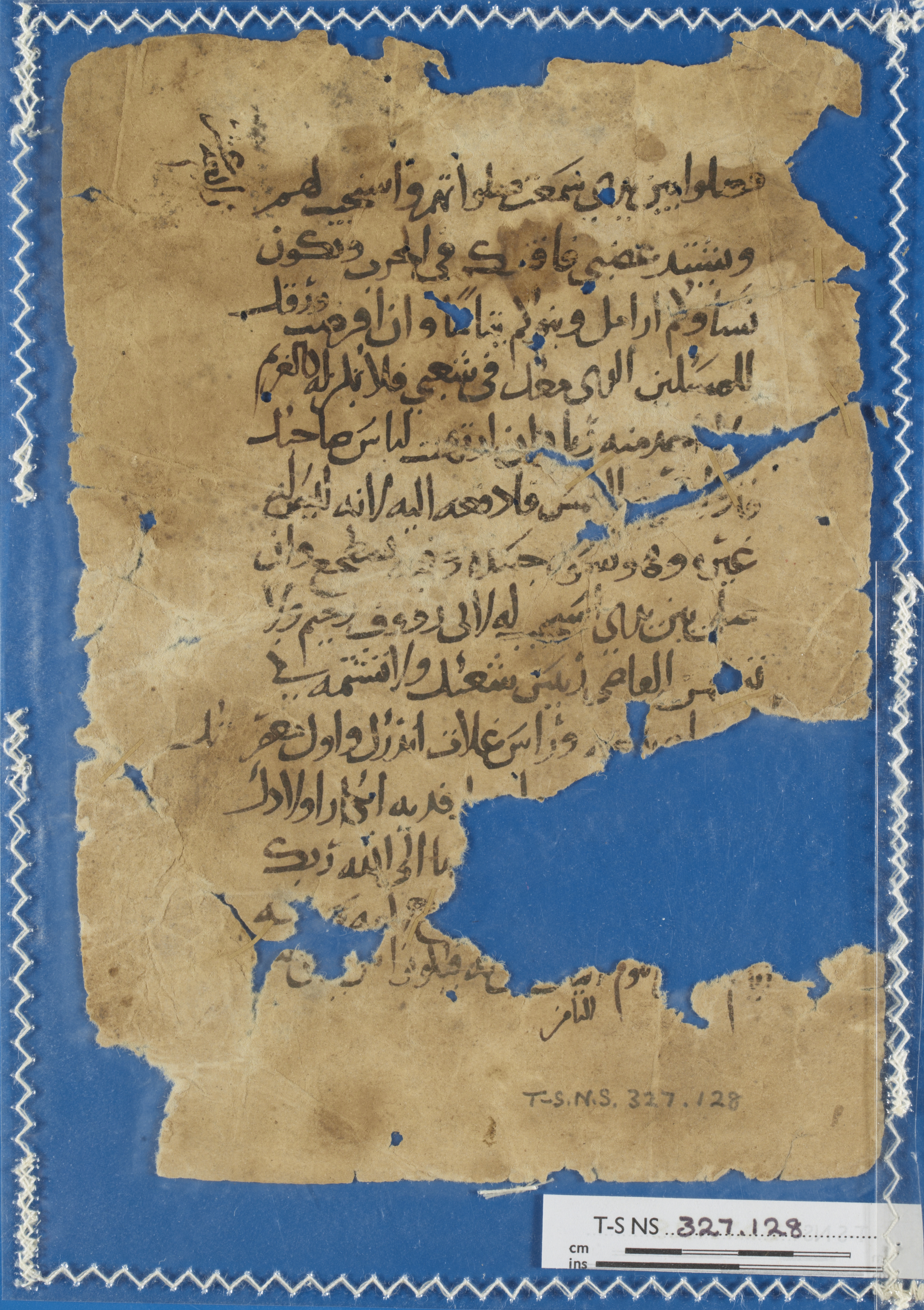
CUL, T-S NS 297.258 (Exodus 34:10-22, 34:13-16)
1 leaf, paper, 9.6 x 13.9 cm, 7 lines per page. T-S NS 297.258 and T-S NS 297.259 are separated parts of the same bifolium.
CUL, T-S NS 297.259 (Exodus 34:9-11, 34:18-22, 35:22-36:2)
2 leaves (bifolium), paper, 20.8 x 28.4 cm, 8-14 lines per page.
Fragments containing translations of Psalms
CUL, T-S Ar. 42.41 (Psalms 69-70, 86-88)
2 leaves (bifolium), paper, 13.7 x 17.7 cm, 13 lines, naskh, torn, rubricated chapter headings. The translation is that of Abū al-Fatḥ ʿAbdallāh ibn al-Faḍl, deacon of Antioch.
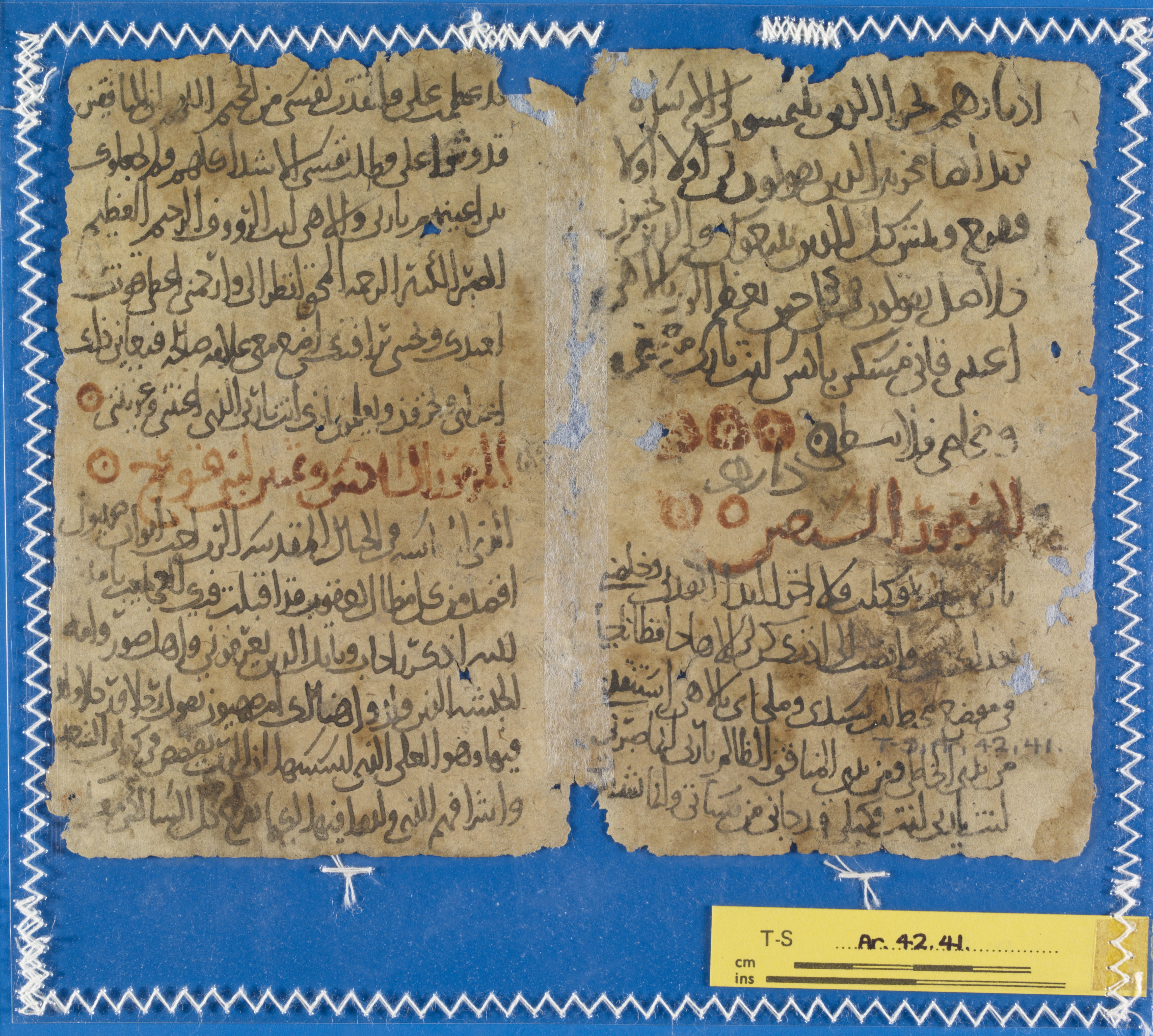
CUL, T-S NS 305.131 (Psalms 118:11-14, 118:18-19)
2 leaves (bifolium), paper, 8.7 x 10.9 cm, 7 lines, naskh with sporadic vocalisation, torn, rubbed and stained.
CUL, T-S NS 327.20 (Psalms 57:5-8, 61:2-6)
1 leaf, paper, 9.5 x 12.3 cm, 6 lines, naskh with sporadic vocalisation, torn, with holes. The translation is identical with that found in the Paris Polyglot and thus was made from a Syriac Vorlage.
CUL, Or. 1080.6.21 (Psalms 79:4-80:6; 82:19-84:6)
2 leaves (bifolium), paper, 15.6 x 21.6 cm, 12-13 lines, naskh, torn and rubbed, rubricated chapter heading noting the stichoi (Arab. istakhon) of each psalm in rūmī numerals. The translation is based on the Septuagint.
Manchester, John Rylands Library, Ar. 840 (Psalms 108-109)[10]
1 leaf, parchment, 15 lines. The fragment exhibits a Greek-Arabic bilingual text that features the end of Psalm 108 and the beginning of Psalm 109. Very little of the text has survived.
Fragments containing translations of the New Testament
CUL, T-S Ar. 52.219 (John 4:46-53, Psalms 23:3-4, John 3:17-21, Hebrews 7:1-17, 3 John, Acts 18:9-21, Psalms 95:7-9, John 6:5-14, Psalms 45:8-9, John 12:35-43, and 1 Corinthians 8:1-7)
6 leaves (3 bifolia), paper, 12.6 x 17.2 cm, naskh, chapter headings are written in a larger script and numerated with Coptic numerals. The collection of biblical readings can be identified as belonging to a Coptic lectionary (Arab. kitāb qaṭamārus), which covers the evening and morning services, as well as liturgy, in the period between the second Sunday and third Saturday of the month of Amshīr.[11]
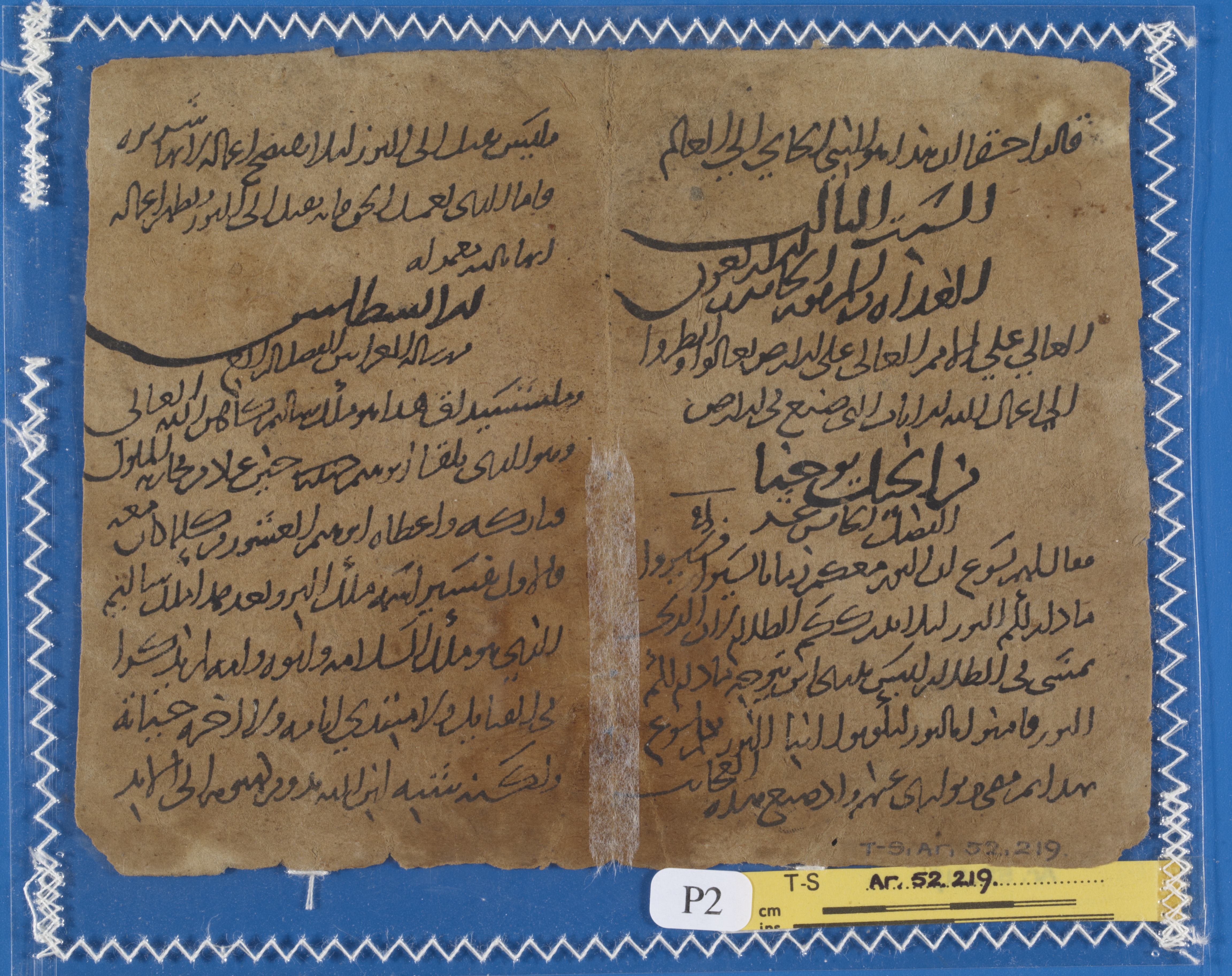
CUL, T-S Ar. 52.220 (Mark 15:15-25, Luke 23:13-25, John 19:1-5, and parts of a homily, possibly by Dionysius of Alexandria)
2 leaves (bifolium), paper, 9.5 x 12.3 cm, 6 lines, Arabic text transcribed into Hebrew letters, with sporadic Tiberian vocalisation, torn, with holes. Like the previous fragment, this one belongs to a Coptic lectionary, covering readings for the third and sixth hours of Good Friday.[12]
CUL, T-S NS 267.57 (Hebrews 8:5-9:13; printed)
1 leaf, paper, 18.2 x 11.6 cm, 25 lines, Arabic in Hebrew letters, the title רסאלה אלי אלעבראניין with the number of the chapter in Hebrew numerals is found on the top of each page. The leaf originated from the missionary print by T.R. Harrison (London, 1847), entitled Arbaʿ kutub min al-ʿahd al-jadīd li-rabbinā Yasūʿ al-masīḥ.[13] This edition reissued in Hebrew letters the Arabic version of the Biblia sacra arabica: Sacrae Congregationis de Propaganda Fide iussu edita, ad usum ecclesiarum orientalium additis è regione bibliis latinis vulgatis (1671-1673).

CUL, T-S AS 198.152 (Matthew 19:23-28, 20:5-10; printed)
1 leaf, paper, 8.5 x 11.6 cm, 10 lines, Arabic in Hebrew letters.[14] This fragment is of the same origin as the previous.
The question remains as to whether the survival of these Christian Arabic translation traditions in the Cairo Genizah collections should be dismissed as accidental or not. Although their number is small in comparison to the large bulk of fragments, that may not reflect the actual quantitative proportion in which such texts circulated in Jewish Fusṭāṭ. Since worn-out manuscripts were deposited in the genizah of the Ben Ezra Synagogue primarily because they were written in Hebrew script, Christian Arabic translations found their way into the genizah in a merely coincidental manner.
Thus we may further ask if
these fragments bear witness to a certain Jewish interest in biblical versions
in Arabic which were of a Christian provenance. Szilágyi has suggested that a
polemically motivated Jewish acquaintance with different genres of Christian Arabic
literature is indicated not only by the presence of such texts in the Genizah
collections, but may also be adduced from the writings of Judaeo-Arabic
authors. For example, Saadiah (882-942), al-Qirqisānī (first half of the 10th century),
and the author of a Judaeo-Arabic commentary on the Psalms (MS RNL Yevr.-Arab.
I:1430) mention not infrequently Christian interpretations and translations of
particular verses.[15]
Hayy Gaon is known to have sent one of his disciples to the East Syriac
Catholicos to inquire about the Syriac translation of Psalms 141:5.[16]
In addition to that, in his Kitāb al-muḥāḍara wa-l-mudhākira, Moshe ibn Ezra (d. 1138) provides
a lengthy discussion about the Arabic version of the psalter produced by the
Mozarab Ḥafṣ b. Albar al-Qūtī.[17] All these cases
suggest that an educated stratum of the medieval arabophone Jewish communities
had an interest in the biblical translations of their neighbours, if only for
polemic purpose. The biblical translations into Christian Arabic preserved in
the Cairo Genizah collections may well constitute further evidence of this.
In any case, these fragments bear significance in their own right and
should be used as textual testimonies for future editions of these important
documents of Christian Arabic literature.
Ronny Vollandt is professor of Judaic Studies at the Ludwig-Maximilians-Universität, Munich. He is the author of Arabic Versions of the Pentateuch. A comparative study of Jewish, Christian, and Muslim sources (2015) and one of the Principal Investigators in the Biblia Arabica consortium.
Suggested Citation: Ronny Vollandt, “Biblical translations into Christian Arabic preserved in the Cairo Genizah collections”, Biblia Arabica Blog, 30 April 2019, DOI: https://doi.org/10.5282/ubm/epub.121805/.
Footnotes[1] The Genizah also preserved many non-Arabic texts of a Christian provenance as the lower layer of palimpsests. See M. Sokoloff and J. Yahalom, ‘Christian palimpsests from the Cairo Genizah’, Revue de l’histoire des textes 8 (1978), pp. 109-132. Also F.C. Burkitt, Fragments of the Books of Kings according to the translation of Aquila (Cambridge, 1897); C. Taylor, Hebrew-Greek Cairo Genizah palimpsests from the Taylor-Schechter collection: Including a fragment of the twenty-second psalm according to Origen’s Hexapla (Cambridge, 1900); and N. Tchernetska, ‘Greek-Oriental palimpsests in Cambridge: Problems and prospects’, in C. Holmes and J. Waring(eds.), ‘Literacy, education and manuscript transmission in Byzantium and beyond (Leiden, 2002), pp. 243-256 for Greek fragments. For Christian Palestinian Aramaic fragments, see A. Smith Lewis and M. Dunlop Gibson, Palestinian Syriac texts: From palimpsest fragments in the Taylor-Schechter collection (London, 1900); updated lists may be found in Ch. Müller-Kessler, Grammatik des Christlich-Palästinisch-Aramäischen, Texte und Studien zur Orientalistik 6 (Hildesheim, 1991). Genizah fragments in Syriac were discussed by W.F. Macomber, ‘An interesting fragment of an East Syrian festal hymnary of the 14th (?) century’, Oriens Christianus 57 (1973), pp. 72-78; S. Brock, ‘East Syrian liturgical fragments from the Cairo Genizah’, Oriens Christianus 68 (1983), pp. 58-79; S. Brock, ‘Some further East Syrian liturgical fragments from the Cairo Genizah’, Oriens Christianus 74 (1990), pp. 44-61; and F. Niessen, ‘New Testament translations from the Cairo Genizah’, Collectanea Christiana Orientalia 6 (2009), pp. 201-221. On a Latin–Hebrew palimpsest, see B. Outhwaite, ‘St Augustine in the Genizah’, Cambridge University Library, Genizah Research Unit, Fragment of the Month (May 2007), http://www.lib.cam.ac.uk/Taylor-Schechter/fotm/may-2007.
[2] For a full list of fragments and references to secondary literature, see K. Szilágyi, ‘Christian books in Jewish libraries: Fragments of Christian Arabic writings from the Cairo Genizah’, Ginze Qedem 2 (2006), pp. 107*-162*.
[3] Again, the reader is referred to Szilágyi’s survey. On Ibn Bahrīz’s ‘Definitions of Logic’, see also G. Ferrario and R. Vollandt, ‘A Judaeo-Arabic version of Ibn Bahrīz’s treatise on logic, T-S K6.181’, Cambridge University Library, Genizah Research Unit, Fragment of the Month (September 2010), http://www.lib.cam.ac.uk/Taylor-Schechter/fotm/september-2010/index.html.
[4] The Cairo Genizah corpus is indispensable for the study of early Judaeo-Arabic translations, which survived exclusively in the various related collections. A selection of fragments has been edited and studied by J. Blau, ‘On a fragment of the oldest Judaeo-Arabic Bible translation extant’, in J. Blau and S. Reif (eds.), Genizah research after ninety years, the case of Judaeo-Arabic: Papers read at the Third Congress of the Society for Judaeo-Arabic Studies (Cambridge, 1992), pp. 31-39; S. Hopkins, ‘On the Vorlage of an early Judaeo-Arabic translation of Proverbs’, Jerusalem Studies of Arabic and Islam 27 (2002), pp. 369-374; Y. Tobi, שרידי תרגום ערבי לתורה קודם לתפסיד רב סעדיה גאון, Massorot 7 (1993), pp. 87-127; Y. Tobi, תרגום ערבי-יהודי עממי נוסף לתורה, in M. Bar-Asher (ed.), מחקרים בלשון העברית ובלשונות היהודים (Jerusalem, 1996), pp. 481-501; Y. Tobi, תפסיר אלפאט’ בכתיב פונטי לחומש שמות וקטעים נוספים לתרגומים עממיים, Beyn Ever le-Arav 1 (1998), pp. 53-74; Y. Tobi, על קדמותם של תרגומי המקרא בערבית-יהודית וקטע חדש מתרגום ערבי-יהודי קדום לתורה, Beyn Ever le-Arav 2 (2001), pp. 17-60; Y. Tobi, תרגומי שמות עצם פרטיים בתרגומי המקרא הערביים-היהודיים מימי הביניים, in A. Demsky (ed.), Studies in Jewish onomastics: In honor of Prof. Edwin D. Lawson on his 80th birthday (Ramat Gan, 2003), pp. 77-84; and Y. Tobi, תרגומים קדומים בלשון הערבית-היהודית לתורה: קטעים חדשים, ha-Ivrit ve-Aḥoteyha 4-5 (2005), pp. 115-143. Translations from the classical period, for example Saadiah’s Tafsīr or the versions of the Qaraites Yefet b. ʿElī and Yeshuʿah b. Yehudah, are attested in great numbers. These texts are also preserved in complete manuscripts in other collections, such as in the Russian National Library in St Petersburg, the British Library in London or the Bibliothèque national in Paris; cf. M. Polliack, The Karaite tradition of Arabic Bible translation: A linguistic and exegetical study of Karaite translations of the Pentateuch from the tenth and eleventh centuries C.E. (Leiden, 1997). Despite the numerous attestations in these collections and others, the Genizah nevertheless contains important evidence as to the early transmission of Saadiah’s Tafsīr which constitutes the distinct majority of fragments belonging to the classical period. Late traditions (16th century onwards), usually recapitulated under the term shurūh, are found only sporadically.
[5] For a summary of the different traditions, see M. Polliack, ‘Bible translations and word-lists in the Cairo Genizah’, Bulletin of the Israeli Academic Center in Cairo 21 (1997), pp. 31-34; M. Polliack, ‘Arabic Bible translations in the Cairo Genizah collections’, in U. Haxen, H. Trautner-Kromann, and K. L. Goldschmidt Salamon (eds.), Jewish studies in a new Europe: Proceedings of the Fifth Congress of Jewish Studies in Copenhagen 1994 under the auspices of the European Association for Jewish Studies (Copenhagen, 1997), pp. 595-620; and M. Polliack, סוגי התרגומים הערביים למקרא בגניזת קאהיר על-פי קטלוג החומר הערבי TS ARABIC, Te’udah 15 (1999), pp. 109-125.
[6] MS CUL, T-S Ar. 1a.136 (Genesis 4:4-15), for example, contains the version of the Samaritan scholar Abū Saʿīd, active in 13th-century Egypt. He did not translate anew the Samaritan Pentateuch into Arabic, but rather revised an earlier version which has been identified in a group of bilingual and trilingual manuscripts in Samaritan letters, and he introduced various scholia to his text. For details, see Ḥ. Sheḥadeh, ‘The Arabic translation of the Samaritan Pentateuch’, in A.D. Crown (ed.), The Samaritans (Tübingen, 1989), pp. 481-516; and Ḥ. Sheḥadeh,התרגום הערבי לנוסח התורה של השומרונים: מבוא למהדורה ביקורתית (unpubl. diss., University of Jerusalem, 1989). In addition, MS Oxford, Heb. d. 64.84 exhibits a Samaritan commentary on Exodus with interspersed translation units.
[7] Saadiah’s Tafsīr was adopted (and adapted) by Christian communities. The manuscript evidence suggests a necessary distinction between different branches of transmission, one Coptic and one Syriac Orthodox (for the book of Genesis only); compare R. Vollandt, The transmission of the Judaeo-Arabic Pentateuch translation of Rav Saadiah Gaon in Arabic characters: A case of textual diffusion (unpubl. diss., Hebrew University of Jerusalem, 2007); and R. Vollandt, Arabic versions of the Pentateuch: A comparative study of Jewish, Christian and Muslim sources, (Leiden, 2015), pp. 222-229. Representatives of the Syriac branch of transmission are the book of Genesis in the manuscripts London, BL Add. 11855; Florence, BML Or. 57 (formerly 12); Leiden, University Library Or. 377; Oxford, Bodl. Hunt. 424; and Coptic Patriarchate, Biblica 22. To a certain extent one may also include Paris, BNF Arabic 4 and Copenhagen, Royal Library Cod. Arab. 75, which demonstrate a clear affinity with this recension.
[8] Cf. Baker and Polliack, Arabic and Judaeo-Arabic manuscripts, p. 383. Although previously identified as a Qaraite copy of the Tafsīr (see R. Vollandt, ‘Some observations on Genizah fragments of Saadiah’s Tafsīr in Arabic letters’, Ginze Qedem 6 (2008), pp. 9*-44*), the new evidence presented here strongly indicates a Christian provenance. Saadiah’s translation in the Coptic branch of transmission is found in a large number of manuscripts; the Tafsīr was extremely popular among Copts. The earliest dated among them is MS Florence, BML Or. 112 (olim 21), copied in 1245-1246, described by W. Bacher, ‘Il manoscritto Fiorentino della traduzione del Pentateucho di Saadja’, Rivista Israelitica 2 (1905), pp. 45-49, and more recently by B. Chiesa, ‘Un testimone della traduzione araba del Pentateucho di Saadia’, in G. Tamani and A. Vivian (eds.), Manoscritti, frammenti e libri ebraici nell’Italia dei secoli XV-XVI (Rome, 1991) pp. 203-213. For a full list of manuscripts, the reader is referred to Vollandt, Arabic versions, pp. 229-242.
[9] Cf. Vollandt, Arabic versions, pp. 64-67.
[10] I thank Alin Suciu for drawing my attention to this fragment.
[11] Cf. Szilágyi, ‘Christian books’, pp. 130*-133*; Niessen, ‘New Testament translations’, p. 206-209. For details of the lectionary, see the latter work.
[12] Cf. Szilágyi, ‘Christian books’, pp. 130*-133*; Niessen, ‘New Testament translations’, pp. 210-211.
[13] Cf. Szilágyi, ‘Christian books’, p. 122*-123*, n59; Niessen, ‘New Testament translations’, p. 203; T.H. Darlow and H.F. Moule, Historical catalogue of the printed editions of Holy Scripture in the library of the British and foreign Bible society (London, 1903), p. 80.
[14] Cf. Niessen, ‘New Testament translations’, p. 203.
[15] Szilágyi, ‘Christian books’.
[16] M. Steinschneider, ‘Das Wörterbuch al-Hâwi des Gaon (Schuloberhauptes) Hai (gestorben 1038)’, Zeitschrift der Deutschen Morgenländischen Gesellschaft 55 (1901), p. 132; A. Maman, לדרכו של רב האי גאון במילונו כתאב אלחאוי , in S. Sharbit (ed.), מחקרים בלשון העברית העתיקה והחדשה לכבוד מנחם צבי קדרי (Ramat Gan, 1999), pp. 242-243; and A. Maman, שרידי מילון ‘כתאב אלחאוי’ לרב האיי גאון מאוספי אדלר וטיילור-שכטר, Tarbiz 69 (2000), pp. 344-345.
[17] Cf. A. Shippers, ‘Medieval opinions on the difficulty of translating the Psalms’, in J. Dyk (ed.), Give ear to my words: Psalms and other poetry in and around the Bible; Essays in honour of Professor V.A. van Uchelen (Amsterdam, 1996), pp. 219-226; and more, recently, Y.M. Dubovick ‘“Oil, which shall not quit my head”: Jewish-Christian interaction in eleventh-century Baghdad’, Entangled Religions 6 (2018), pp. 95-123.


Leave a Reply